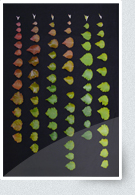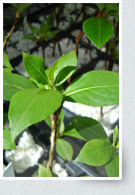

Effects of CO2 concentrations on isoprene emission in poplar and implications for photosynthetic thermotolerance
Isoprene is a volatile organic compound that is emitted by some, but not all, plants. Leaves that emit isoprene are better able to tolerate high light and temperature stress, maintaining high rates of photosynthesis under these stressful conditions. But isoprene emission is also negatively correlated with CO2 concentrations: the low CO2 concentrations of the pre-Industrial past promote high isoprene emission rates, while emission is suppressed at high CO2 concentrations, such as those predicted for the near future.
We recently published a paper showing that poplars grown at low CO2 concentrations had greater tolerance of heat and light stress when they produced isoprene than did poplars where isoprene emission was suppressed (Way, Schnitzler, Monson and Jackson, 2011 – pdf). But at high CO2, rates of isoprene emission in poplars producing isoprene were low, and there was little difference in stress tolerance between trees that could emit isoprene and those where that ability was suppressed. Thus, rising CO2 concentrations might negate the advantage that species producing isoprene have with regard to maintain carbon fixation rates during heat and light stress.
Non-targeted metabolomic profiling has shown us that there are substantial CO2-dependent differences between isoprene-emitting and non-emitting leaves in multiple metabolic pathways. We are linking these metabolic changes to leaf physiology and stress tolerance to better understand the role of isoprene production in plants. This work is a collaboration with Jörg-Peter Schnitzler, Andrea Ghirardo, Basem Kanavati, Phillippe Schmitt-Kopplin and Jürgen Esperschütz (Helmholtz Zentrum, Munich), Russ Monson (University of Colorado) and Rob Jackson (Duke University).

How do tree height and leaf area development limit carbon fixation through effects on stomatal conductance?
We're making measurements of stand-level carbon and water fluxes from loblolly pine (Pinus taeda) stands to understand how tree height and canopy development affect hydraulic limitations to stomatal conductance and carbon fixation. This USDA-funded project involves using a mobile eddy covariance system (see picture), as well as the synthesis of existing data sets from the Duke Forest in North Carolina, in collaboration with Gaby Katul, Stefano Manzoni, Sari Palmroth, Ram Oren and Amilcare Porporato, all from Duke University. See more at the project webpage.

Using optimization theory to model the effects of elevated atmospheric CO2, high temperatures and changes in precipitation on ecosystem carbon fluxes
This project involves using stomatal optimization theory, whereby we assume that stomata function to optimize carbon gain per unit water loss. We are using this concept to predict leaf-level nitrogen and water use efficiency at varying atmospheric CO2 concentrations, temperatures and water availabilities. These results are then scaled to the canopy-level and coupled to models of soil biogeochemistry and stochastic rainfall patterns. In the end, our goal is to allow stomatal behaviour to feedback into tree biomass allocation based on soil carbon pool turnover and nitrogen availability.
The model is being tested with data from the Duke FACE (Free Air CO2 Enrichment) site and from across the Ameriflux network. This work is a collaboration with Gaby Katul, Stefano Manzoni, Ram Oren, Sari Palmroth and Amilcare Porporato (all at Duke University) and is funded by the US Department of Energy; more information on the project can be found here.

What underlies isohydric and anisohydric behavior in trees?
Isohydric species close their stomata as water becomes limiting to protect their leaves and stems from drought stress. Anisohydric trees allow their stomata to stay open longer, with a greater risk of drought-induced damage, but also a longer period of carbon uptake during water stress.
This project is investigating what anatomical and physiological traits are involved in these different strategies in two closely related poplar lines. We're examining aquaporin activity, hydraulic traits and drought tolerance behavior. This work is a collaboration with Ram Oren and JC Domec at Duke University and Menachem Moshelion at the Hebrew University of Jerusalem in Israel and is funded by the U.S. Israeli Bi-national Science Foundation.

